Email referral programs are the best referral asset in your arsenal. They’re scalable, low lift and easy to automate. Sending an email to a friend is easy; it requires very little effort or commitment.
It’s a win-win for you and your customers.
Of course, just because it’s the best asset, doesn’t mean it can’t be optimized. It’s easy to maximize the ROI of your referral email programs, but you need the right tools and tactics. We analyzed 14 email referral programs to identify best practices for making your campaigns as effective as possible.
By utilizing the following techniques (key takeaways) in your referral emails, you’ll be able to create a program that’s both desirable and easy for customers to participate in.
1. FabFitFun
FabFitFun is a subscription box service that delivers beauty and wellness products. Its email referral program offers new customers a free Starter Box, valued at over $75. All the referee has to do is redeem their free box within a week and pay for shipping.
FabFitFun appeals to its customers’ emotions. Phrases like “make their day” and “Brighten a friend’s day at home” positions the referral program as an opportunity for customers to show friends and family that they care.
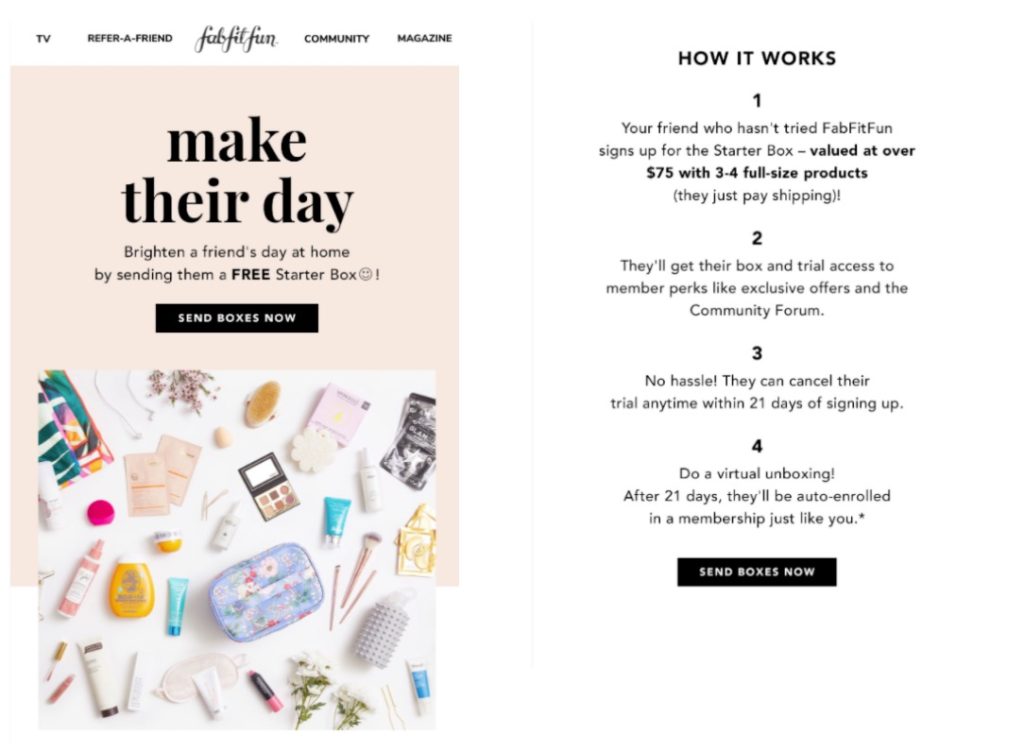
Key takeaway: appeal to emotions
Appealing to customers’ emotions is an effective strategy for encouraging referrals without offering the customer anything in return. In thecase of FabFitFun, customers feel that by gifting a free Starter Box, they’re doing something special for their friends and family. And for many people, that’s a powerful incentive in and of itself.
We also like how FabFitFun breaks the referral process down into four easy-to-understand steps. Customers instantly know what they can expect, along with what their friends and families can expect.
2. Earny
Earny helps people save money. The company offers its customers $5 for every referred friend who makes a purchase with the Earny app.
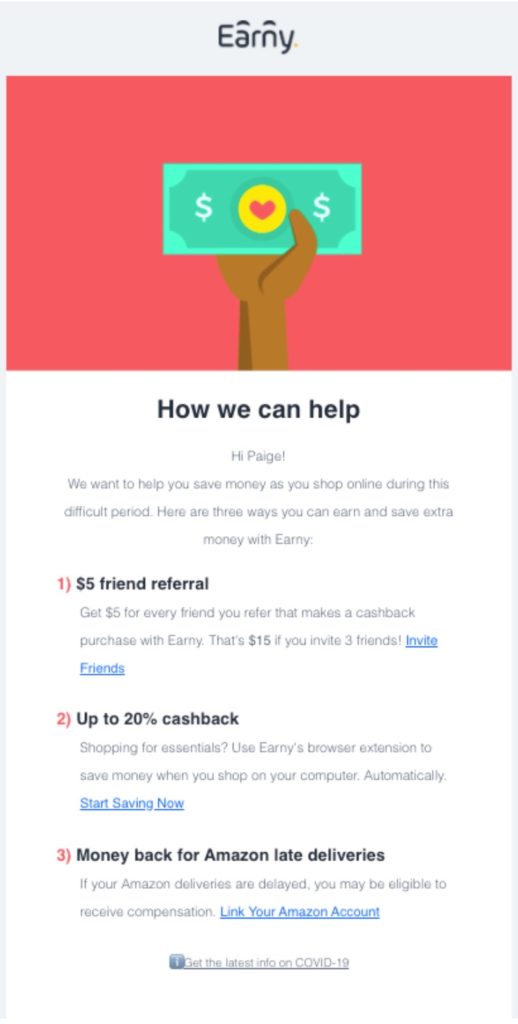
Key takeaway: Show support
Earny increases the appeal of its referral program by offering it as a response to current events. “We want to help you save money as you shop online during this difficult period” calls attention to the financial difficulties facing consumers amidst the COVID-19 pandemic. This type of messaging lets customers know you’re thinking about them, which can improve overall engagement with your brand.
3. Drop
Drop is a customer loyalty program that gives users points for purchases made through the app. Those points can then be redeemed for gift cards to various retailers.
Its email referral program offers customers and referred friends 10,000 points each for a limited time only. The caveat is that referred friends have to earn 1,000 points before either party can receive their 10,000 point bonus.
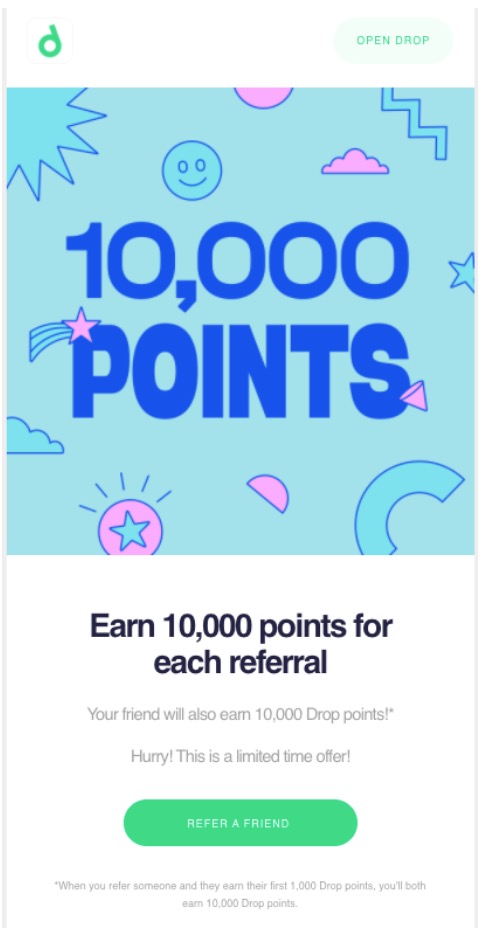
Key takeaway: play on fomo
This particular referral program appeals to customers’ FOMO (fear-of-missing out) by emphasizing a sense of urgency. Exclamation points and words like “Hurry!” intensify the urgency and encourage customers to act quickly.
Drop also highlights the bonus itself by repeating “10,000 points” multiple times throughout the text. Couple this with the massive, colorful image at the top, and you’ve got an eye-catcher that’s hard to ignore.
4. Seated
Seated is an app for booking reservations at restaurants. Users receive cash-back credits for every reservation they complete with the app.
Its email referral program offers two tiers of rewards:
- Customers can earn $20 for every friend they refer, up to five friends.
- Customers who successfully refer five friends can earn money every time those friends dine out using the app.
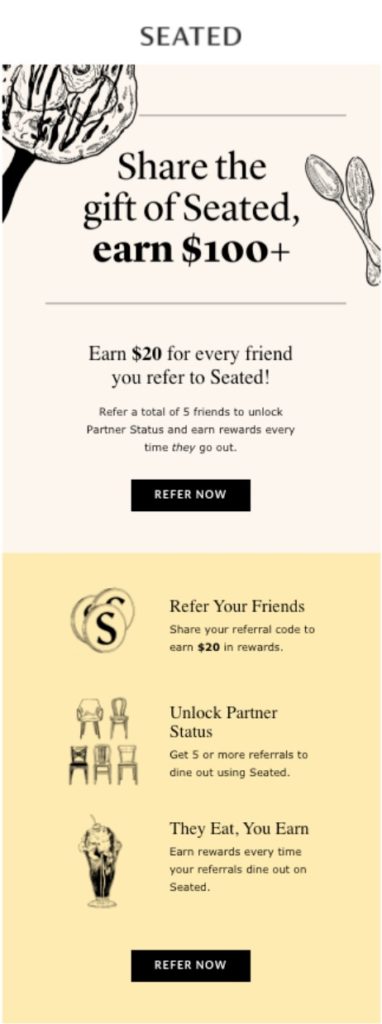
Key takeaway: Show Maximum Earnings
Some companies only explain what customers can earn per referral. Seated takes this one step further by showing its customers what they’re capable of earning beyond that. Sure, $20 per referred friend is a great deal, but $100+ dollars sounds even sweeter. Don’t just show individual prizes your referrers can earn; show the maximum earnings they’re capable of receiving.
5. Girlfriend Collective
This recycled activewear company offers customers a free pair of leggings when they refer a friend. Referred friends get $10 off their first purchase of $95 or more.
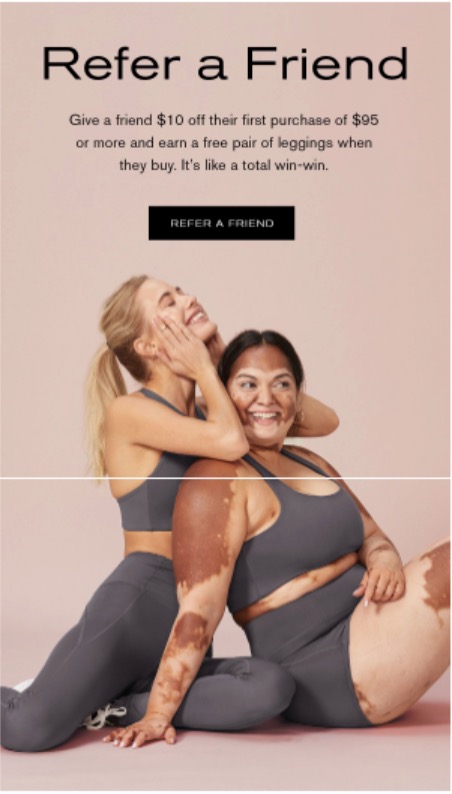
Key takeaway: Put the prize on display
Instead of just telling customers what they’ll get for referring friends, show them. Girlfriend Collective uses models in its email referral program to showcase the free leggings customers could earn. By putting an image to the prize, you improve its appeal – and the desire to participate in the program.
6. Seamless
Seamless is an online food ordering and delivery service. Referrers get $12 each time a referred friend places their first order.
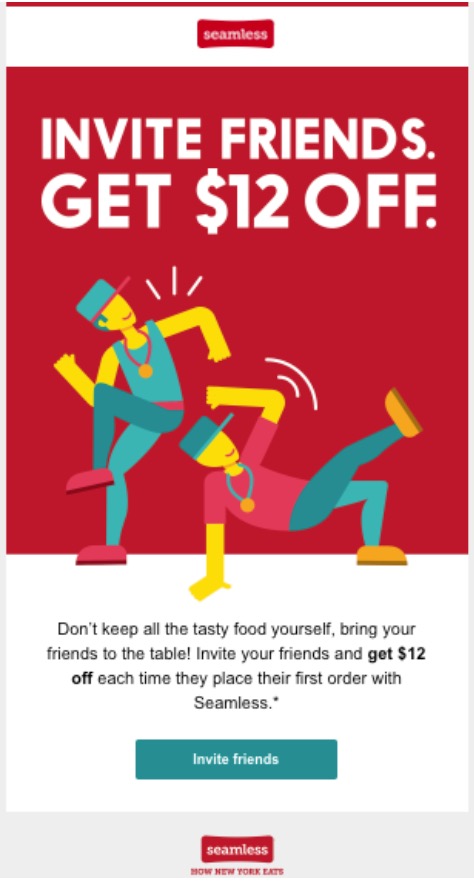
Key takeaway: Make it eye-catching
The images in Seamless’s referral email are instantly eye-catching. Fun images and vibrant colors can help your referral email stand out in a busy inbox. The more captivating your emails are, the less likely your customers will be to immediately click out of them.
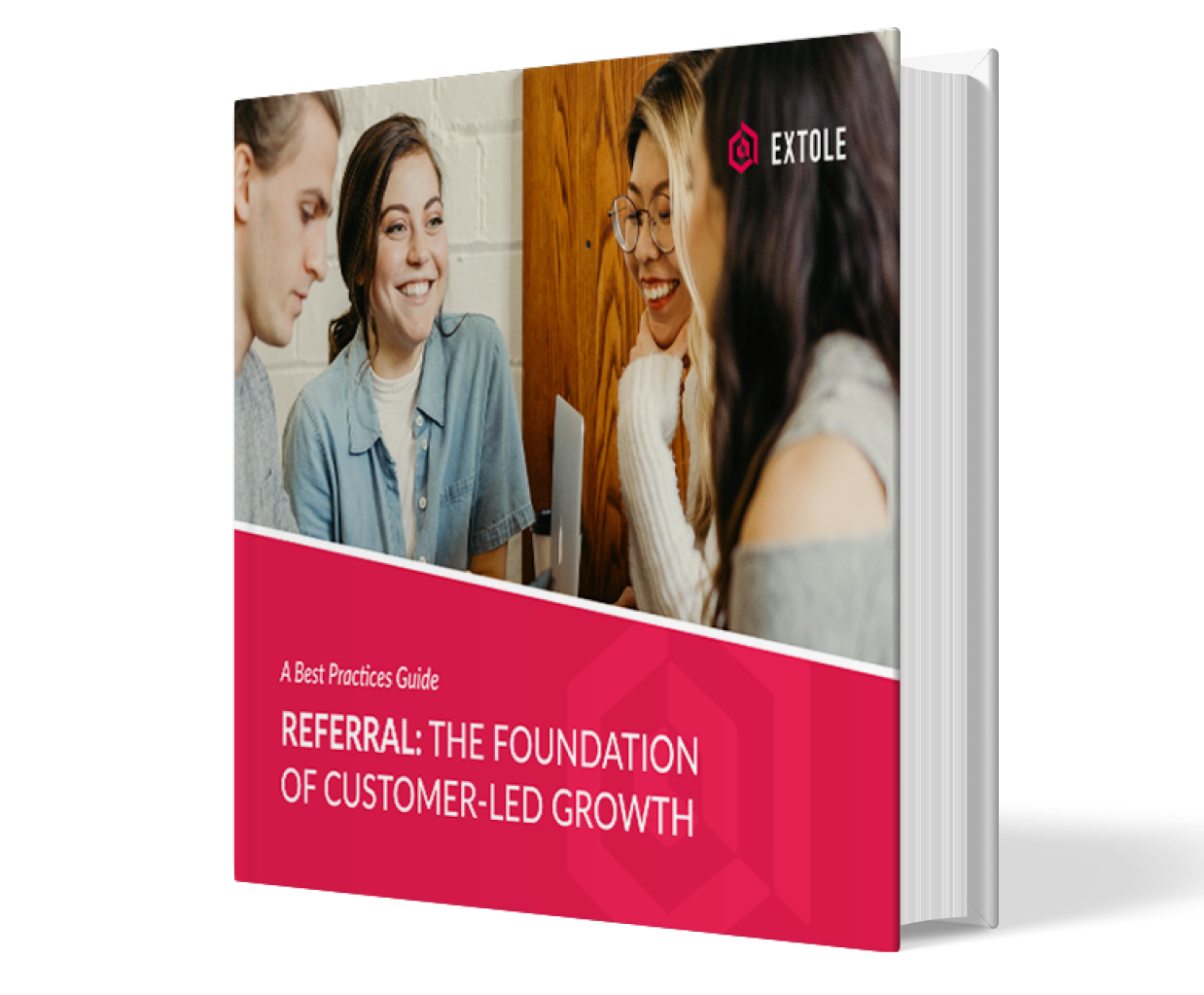
Referral Marketing – The Best Practices You Need to Know
Written by veteran referral marketers, this guide will help you optimize your referral marketing program and supercharge growth.
Get the Guide7. Acorns
The investment app Acorns has an email referral program that offers customers $250 when they refer four of their friends.
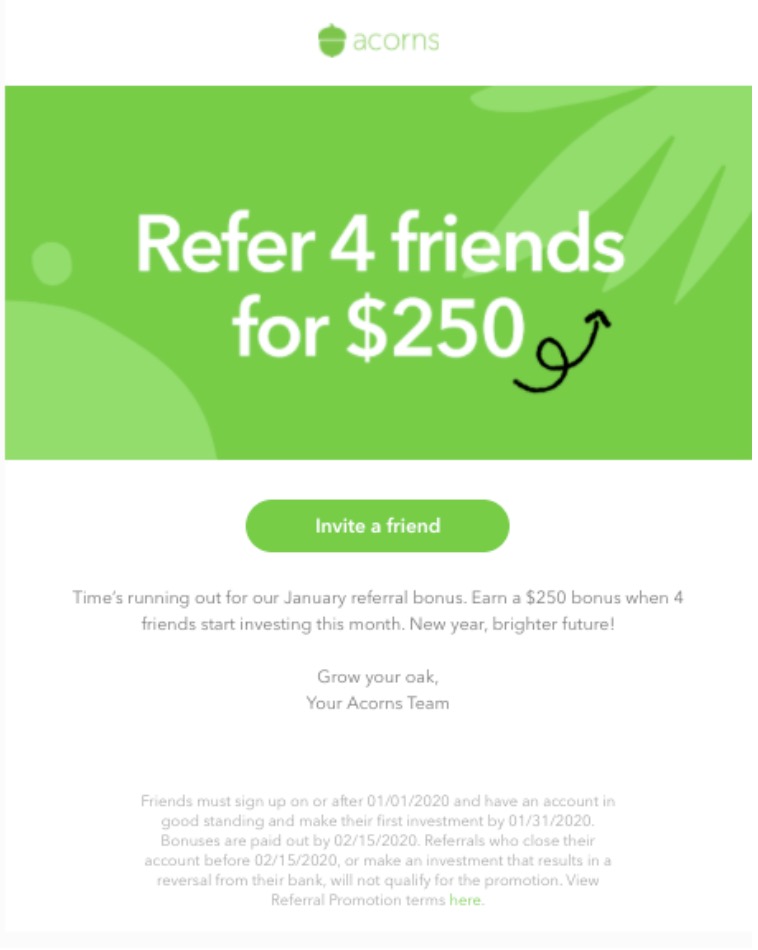
Key takeaway: Keep the messaging simple
Sometimes, simplicity is best. Acorns’ referral email clearly tells customers what they can earn while keeping it short and sweet. The less time it takes to get your point across, the less likely you are to lose your reader’s attention.
Plus, the “Invite a friend” button creates a visual call to action (CTA) that is easy for the reader to follow.
8. Chipolo
Chipolos are Bluetooth-enabled devices that help customers keep track of valuable items like wallets or keys. The company’s email referral program gives customers unique referral links they can share with friends. When three friends buy the product with a customer’s unique link, that customer gets a free Chipolo.
The referred customer also receives a 20% discount on their first purchase.
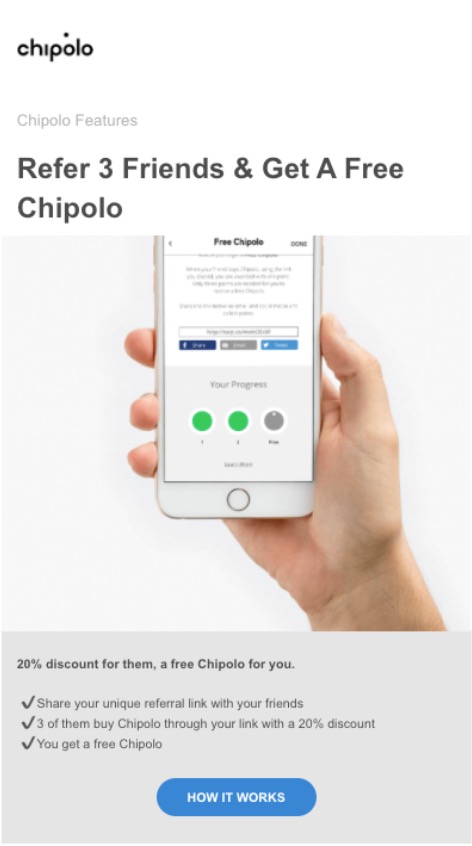
Key takeaway: Show clear expectations
Chipolo provides a screenshot of what the referral process looks like. This shows customers what they can expect when they participate, which eases their minds and makes them less likely to abandon the process halfway through.
9. Coinbase
Coinbase’s email referral program offers both the customer and the referred friend $10 worth of free Bitcoin when they participate.
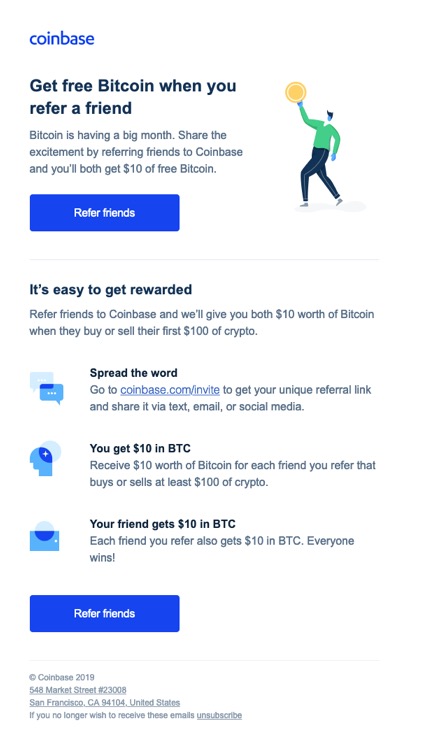
Key takeaway: Optimize for various email clients and devices
As Really Good Emails demonstrates, Coinbase’s referral emails are optimized for multiple email clients. Prior to scheduling your campaigns, make sure you test your referral emails on various platforms and devices. Blown-out images and cut-off text are quick ways to lose your customers.
10. Justworks
Justworks is a payroll and HR company. Its referral program offers massive rewards for customers who bring in large teams and entire businesses. Here’s what one of its referral emails looks like:
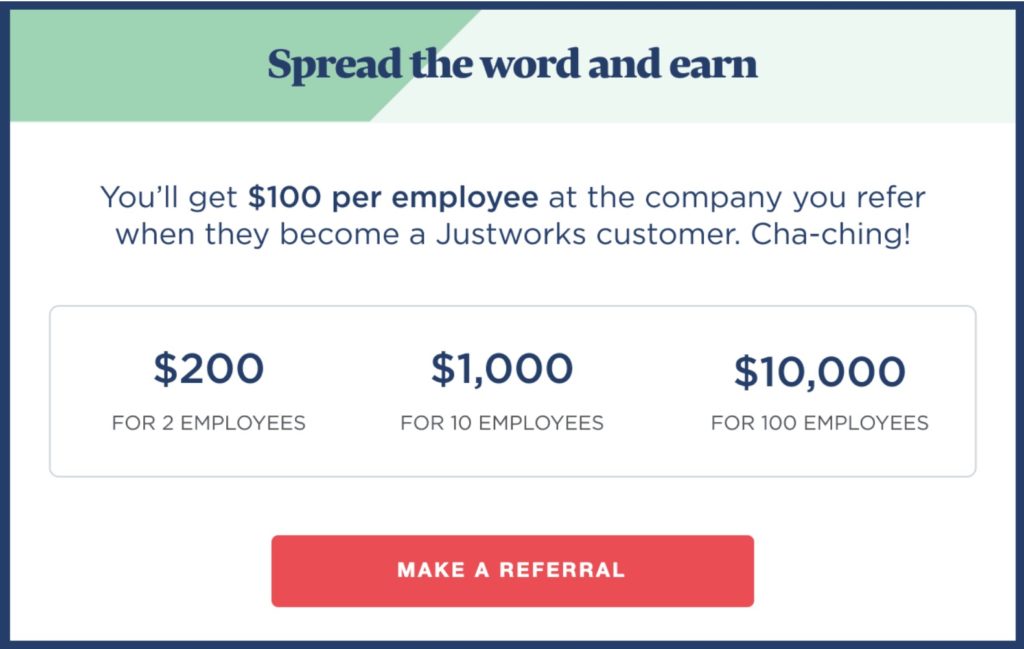
Key takeaway: Show the potential for the customer
Similar to Seated, Justworks’ email referral program doesn’t stop at the $100 per employee selling point. The company also shows customers what they have the potential to earn, depending on how many people they refer. The pro tip here is to use exponentially increasing numbers to show a greater range of potential earnings. The more money a customer knows they can earn, the more likely they’ll be to participate in the referral program.
11. Planted
Planted is a recruiting service that connects non-technical people with jobs in the startup industry. Its email referral program offers a double-sided reward of $100 each for both the referrer and referee.
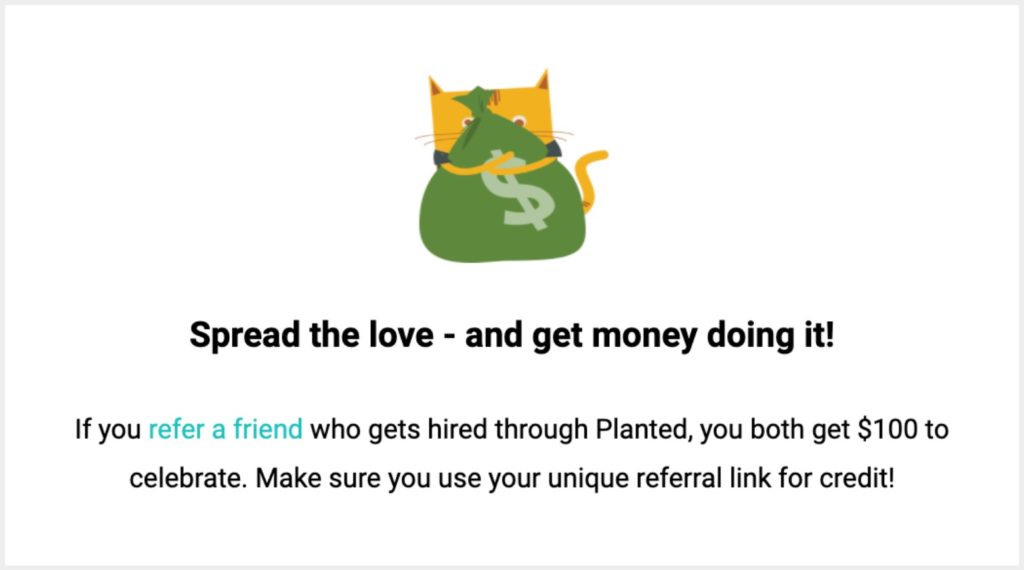
Key takeaway: Make it easy to participate
This referral email is practically frictionless. Planted makes the incentive clear and gives you a unique referral link within the email. When customers join the referral program, they’ll see a big, eye-catching button that lets them track which friends they’ve invited, who’s joined, and who’s been offered a job. This adds a social aspect to the referral program, which can encourage customers to engage with it more often.
Planted also provides customers with pre-made templates to share through email, Twitter and Facebook. Customers can expand their outreach across channels without needing to do any of the work themselves. It’s simple, fun and interactive.
12. Dropbox
Cloud storage system Dropbox has about 600 million users and continues to grow every year. Part of this growth is due to Dropbox’s email referral program, which, in 2010, increased signups by a whopping 60%. When a customer successfully referred a friend to Dropbox, the company sent that customer a confirmation email, similar to the one below.
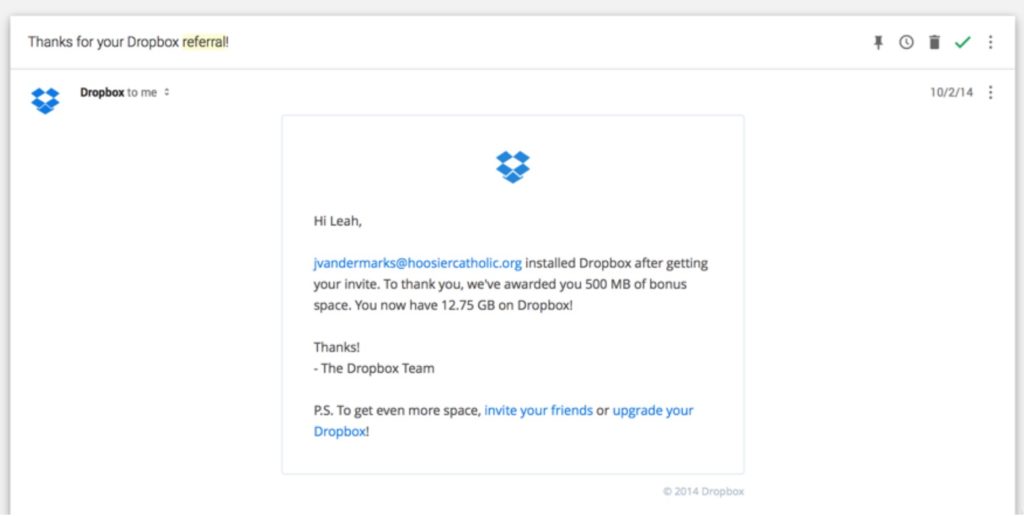
Key takeaway: Actualize the prize
Even if customers are receiving value from your referral program, they may not realize it. But with a confirmation email like the one above, your customers can see that reward actualized. And when people recognize the benefit they’re getting from your referral program in real-time, they’re more likely to refer again.
13. The Hustle
The Hustle is a daily newsletter that keeps readers up-to-date on the latest tech and business developments.
The company incentivizes customers to refer friends by offering them free Hustle merchandise. The more referrals a customer sends, the better the prizes get. As you’ll notice in the photo below, The Hustle specifically asks customers to share their referral links across social media.
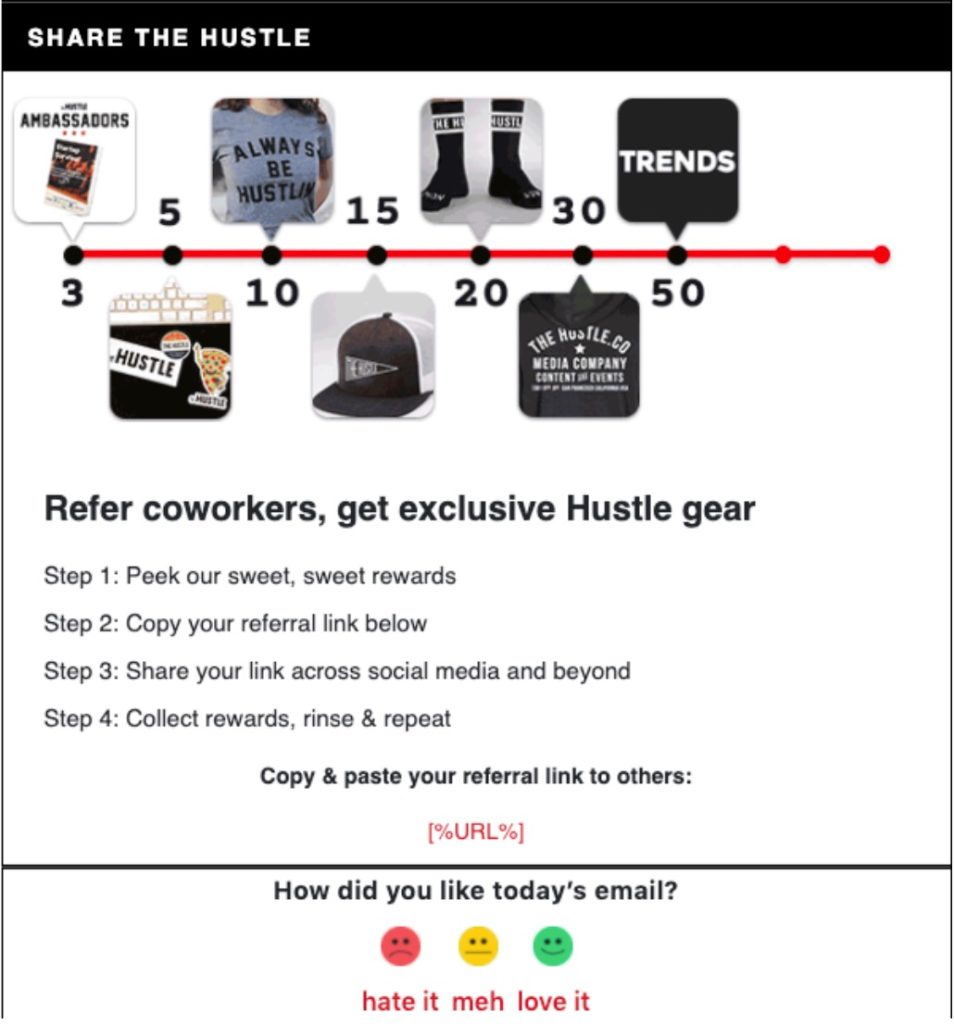
Key takeaway: Make it a social event
This email referral program is perfectly set up for social media distribution. The Hustle uses images to visually represent the prizes customers can win and encourages social shares with an easy-to-copy-and-paste referral link. And because it’s social media, not only will referrers want to spread the word to get a pair of socks, they’ll also want to post a photo of themselves on social media wearing the socks.
14. CareerFoundry
CareerFoundry offers online courses that give people the skills they need to break into the tech industry. One of its referral emails (shown below) was sent to contract employees who mentor and teach the courses-many of whom acquired their skills by taking a course themselves.
Its program offers massive double-sided benefits, which incentivizes advocates to talk up CareerFoundry and incentivizes their friends to listen.
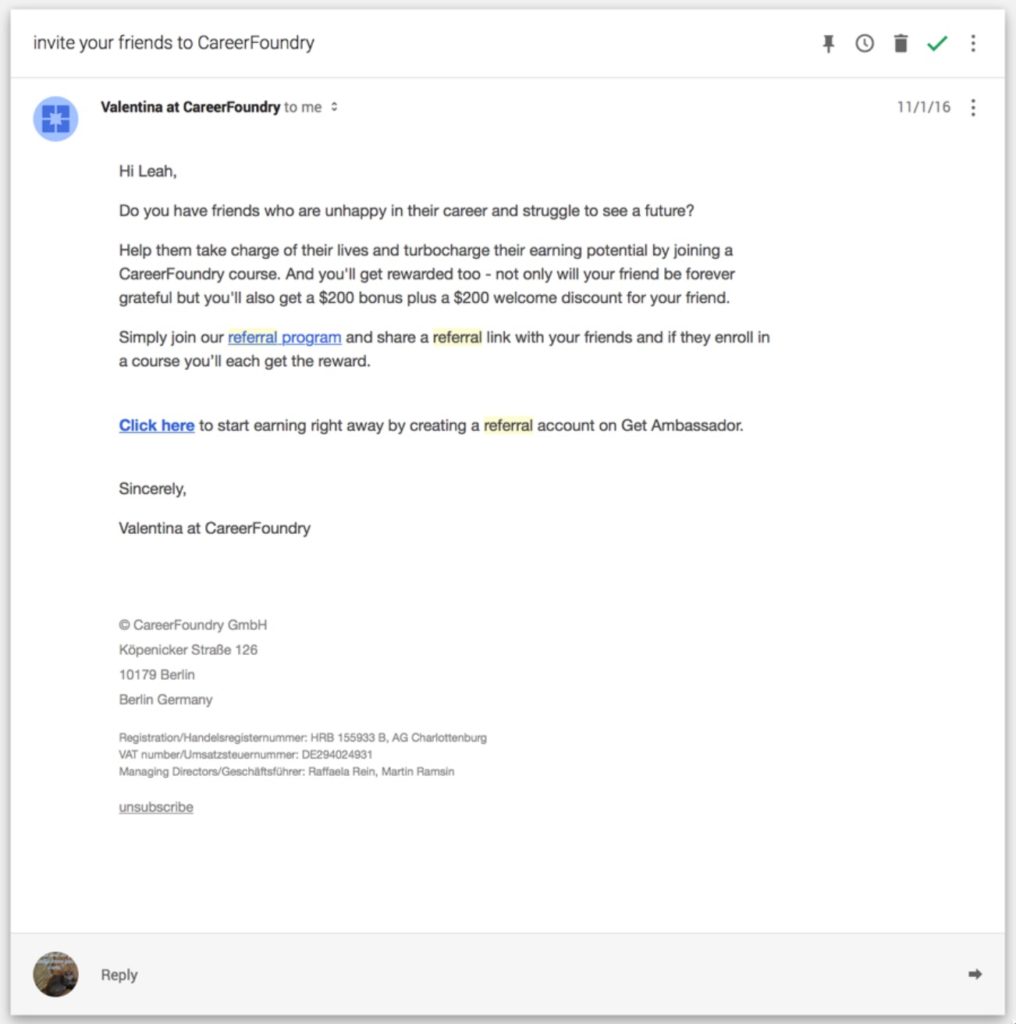
Key takeaway: target people who know the value of your program
Targeting the people who know firsthand the value of your program (in this case, it’s teachers) increases the likelihood that they’ll sing your praises.
Get your customers talking with referral email programs
The most successful email referral programs are the ones that provide the highest-value rewards with the least amount of ask. Your incentives should not only be attractive; they should be clear, obvious and easy to obtain.
Use the key takeaways from the email referral program teardowns above to make it as appealing and effortless as possible for your customers to spread the word about your brand.




